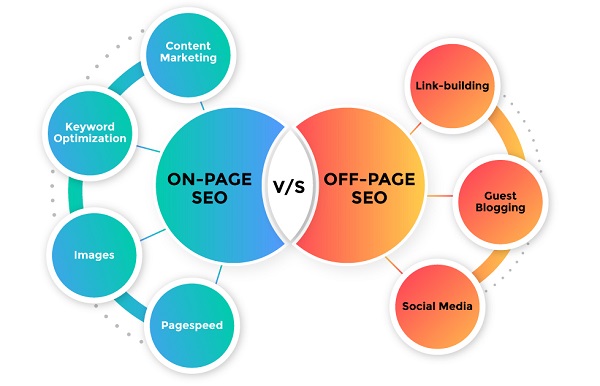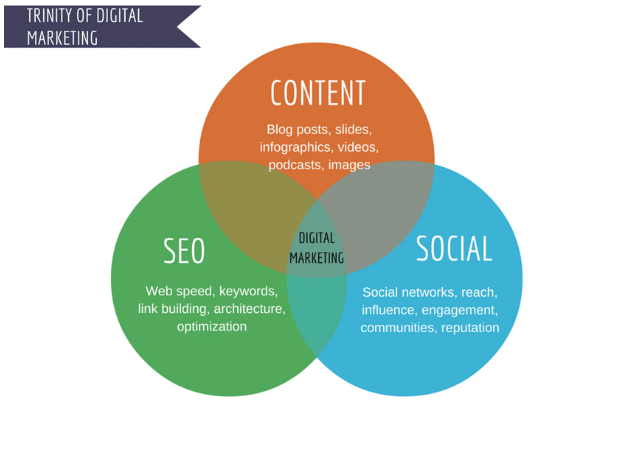Unlock the secrets of SEO and Content Marketing – discover how they work together to boost your online visibility today!

Image courtesy of via DALL-E 3
Table of Contents
Welcome, young readers! Today, we’re going to dive into the world of SEO and content marketing. Don’t worry if these terms sound a bit fancy right now. By the end of this article, you’ll have a clear idea of what they mean and why they are essential to understand.
What is SEO?
SEO, which stands for Search Engine Optimization, is all about making sure websites show up when you search for something on Google or other search engines. Think of it as a magical way to help websites get noticed in a sea of information online.
What is Content Marketing?
Now, content marketing is the fun part! It’s like creating exciting stuff such as blogs, videos, and social media posts to grab people’s attention and get them interested in a product or service. It’s all about being creative and sharing useful and engaging content.
Why the Relationship is Important
So, why should you care about the relationship between SEO and content marketing? Well, when these two work together, they can help websites attract more visitors. SEO makes sure the website is easily found, while content marketing keeps people entertained and wanting to come back for more.
How Search Engines Work
Search engines like Google are like giant libraries where you can find information from all over the internet. Let’s take a look at how these search engines find and rank web pages.
Crawlers and Indexing
Search engines use special bots called crawlers to explore the internet and gather information from different websites. These crawlers then bring back the information they find to build a massive library called an index.
Search Algorithms
Once a search engine has collected all this information, it needs a way to decide which web pages are the most relevant to a user’s search. This is where search algorithms come into play. Algorithms are like a set of rules that help search engines determine the order of search results. They look at various factors like keywords, content quality, and website authority to rank pages based on what they think is most helpful to the user.
The Basics of SEO
In the world of SEO, keywords are like keys that unlock the doors to your website. When people search for something online, they type in specific words or phrases to find what they’re looking for. These are the keywords. By using the right keywords on your website, you can make sure that search engines like Google can easily find and show your site to those searching for related topics.
On-Page SEO
On-page SEO is all about making sure your website is optimized to rank well on search engines. This includes things like using relevant keywords in your page titles, headers, and image descriptions. By optimizing these on-page elements, you’re helping search engines understand what your website is about and where it should appear in search results.
Off-Page SEO
Off-page SEO is like building connections with other websites to boost your own site’s credibility. When other reputable sites link back to your content, it tells search engines that your website is a reliable source of information. This can help improve your rankings and drive more traffic to your site.
Creating Great Content
In order to attract visitors to your website, it is essential to create quality content that both people and search engines will love. When you create content that is valuable and interesting, you increase the chances of people finding and enjoying what you have to offer. Let’s explore what makes content great and the different types you can create.

Image courtesy of www.linkedin.com via Google Images
What Makes Quality Content?
Quality content is all about providing value to your audience. This means creating content that is helpful, informative, and engaging. When your content solves a problem, answers a question, or entertains your readers, they are more likely to engage with it and share it with others. Quality content is also well-written, easy to understand, and fun to read.
Types of Content
There are various types of content you can create to engage your audience. Some popular forms include blogs, videos, and infographics. Blogs allow you to share in-depth information and insights on topics relevant to your audience. Videos are engaging and can help you connect with your audience on a personal level. Infographics are visually appealing and can convey complex information in a simple and attractive way. By diversifying the types of content you create, you can reach a wider audience and keep them coming back for more.
Combining SEO and Content Marketing
In the world of websites and online content, SEO (Search Engine Optimization) and content marketing are like peanut butter and jelly – they go together perfectly! When you combine these strategies, your website can attract more visitors and climb higher on the search engine results page. Let’s dive into how you can best use SEO and content marketing together for success.
SEO Strategies in Content
SEO strategies are like secret ingredients that help search engines find your website. One important strategy is using the right keywords in your content. These keywords are the words or phrases that people type into search engines when they’re looking for something. By including these keywords naturally in your content, you can improve your website’s chances of being discovered by search engines.
Content Strategies for SEO
Creating valuable content regularly is a key part of content marketing. When you consistently produce helpful and interesting content, you not only attract readers but also boost your SEO. Search engines love fresh content, so by regularly updating your website with blogs, videos, or infographics, you can improve your search engine rankings.
Measuring Results
In order to see how well your SEO and content marketing efforts are performing, it’s important to measure your results. This will help you understand what’s working and what might need improvement.

Image courtesy of emeritus.org via Google Images
Using Analytics Tools
Analytics tools are like magic mirrors that show you how many people are visiting your website, where they’re coming from, and what they’re doing while they’re there. One popular tool for this is Google Analytics. It’s like having a personal detective who can tell you all about your website visitors.
What to Measure
When looking at your analytics, there are a few important things to keep an eye on. You’ll want to know how many people are visiting your site, how long they’re staying, which pages they’re looking at the most, and if they’re taking any actions like signing up for a newsletter or making a purchase. These metrics can give you a good idea of what’s working well and what might need some tweaking.
Tips for Success
Now that you understand how SEO and content marketing work together, it’s time to learn some tips for success in combining these two strategies.
Be Consistent
Consistency is key when it comes to creating content for your website. Make sure you have a regular schedule for posting blogs, videos, or other content. This helps keep your audience engaged and coming back for more.
Stay Updated
It’s important to stay updated with the latest changes in search engine algorithms and content marketing trends. By staying informed, you can adjust your strategies to stay ahead of the competition and attract more visitors to your site.
Common Mistakes to Avoid
When it comes to combining SEO and content marketing, there are some common mistakes that you should avoid in order to achieve the best results. Let’s take a look at what these pitfalls are and how you can steer clear of them.

Image courtesy of infographicworld.com via Google Images
Overusing Keywords
One big mistake that people make is overusing keywords in their content. While it’s important to include relevant keywords that people might use to search for your content, stuffing your content with too many keywords can actually backfire. Search engines like Google are smart enough to recognize when content is being overloaded with keywords, and they may penalize your website for it. Instead, focus on using keywords naturally and sparingly throughout your content.
Ignoring Analytics
Another mistake to avoid is ignoring analytics. Analytics tools like Google Analytics provide valuable insights into how your website is performing, how visitors are interacting with your content, and where improvements can be made. By not tracking your performance through analytics, you’re essentially flying blind and missing out on important data that can help you refine your SEO and content marketing strategies. Make sure to regularly check your analytics to see what’s working and what needs adjustments.
Conclusion
In this blog post, we have explored the essential relationship between SEO and content marketing. By understanding how these two elements work together, you can enhance your website’s visibility and attract more visitors. Let’s recap the key points we’ve covered and emphasize the significance of utilizing SEO and content marketing in unison.
Recap of Key Points
We began by defining SEO as Search Engine Optimization, which helps websites get found on search engines like Google. Content marketing, on the other hand, involves creating engaging content to attract your target audience. We also delved into how search engines work, the basics of SEO including keywords and on-page/off-page optimization, creating quality content in various formats, and the importance of combining SEO and content marketing strategies. Furthermore, we discussed the significance of measuring results through analytics tools and provided practical tips for success while highlighting common mistakes to avoid.
Final Thoughts
As we wrap up, I encourage you to start implementing SEO and content marketing strategies together to enhance your website’s performance. By producing valuable content that is optimized for search engines, you can not only improve your online visibility but also connect with your audience effectively. Remember to stay consistent with your content creation efforts and stay updated on the latest trends in SEO and content marketing. By utilizing these tools effectively, you can take your website to new heights and reach a broader audience. Best of luck on your journey towards mastering SEO and content marketing!
Want to turn these SEO insights into real results? Seorocket is an all-in-one AI SEO solution that uses the power of AI to analyze your competition and craft high-ranking content.
Seorocket offers a suite of powerful tools, including a Keyword Researcher to find the most profitable keywords, an AI Writer to generate unique and Google-friendly content, and an Automatic Publisher to schedule and publish your content directly to your website. Plus, you’ll get real-time performance tracking so you can see exactly what’s working and make adjustments as needed.
Stop just reading about SEO – take action with Seorocket and skyrocket your search rankings today. Sign up for a free trial and see the difference Seorocket can make for your website!
Frequently Asked Questions (FAQs)
What if I don’t have a website?
If you don’t have a website, understanding SEO and content marketing can still be incredibly beneficial. You can apply the principles you learn to social media platforms like Instagram, YouTube, or even writing engaging posts on platforms like Medium. Knowing how to create content that people enjoy and how to optimize it for search engines can help you stand out online, no matter where you are sharing your content.
How long does it take to see results?
Seeing results from your SEO and content marketing efforts can take some time and patience. It’s like planting seeds in a garden – you need to nurture them with consistent effort before you start seeing the flowers bloom. The timeline for seeing results can vary depending on the competitiveness of your industry, the quality of your content, and how well you implement SEO strategies. Remember, good things take time!
Do I need to know a lot about computers?
No, you don’t need to be a computer expert to understand and start using SEO and content marketing. Having a basic understanding of how the internet works and being able to navigate websites and social media platforms is enough to get started. There are many user-friendly tools and resources available online that can guide you through the process of optimizing your content for search engines and creating engaging material for your audience.







